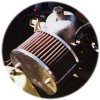Type of fluid
|
Application
|
Comments
|
|
20 wt
|
Factory Original
|
Probably works great on brand new carbs, but there aren't a lot of
those around these days! |
|
ATF
|
Performance
|
Works very well. Thin enough to be responsive, but thick enough
to smooth out off-idle performance. Requires that carbs be in good
tune, and that throttle shaft bushings not be too badly worn out. |
|
20/50
|
Moderate Driving / Worn Carbs
|
Thicker than either of ATF or 20 wt. Overall performance is similar,
but responsiveness suffers. Makes the vehicle run better at low RPM.
Thick enough to counteract leaking throttle shaft bushings and poor tune. |
 SU carburetors got you
down? Does it seem like everyone you ask for help says, "Those carbs
are junk." If that's you, read on:
SU carburetors got you
down? Does it seem like everyone you ask for help says, "Those carbs
are junk." If that's you, read on: SU carburetors got you
down? Does it seem like everyone you ask for help says, "Those carbs
are junk." If that's you, read on:
SU carburetors got you
down? Does it seem like everyone you ask for help says, "Those carbs
are junk." If that's you, read on: